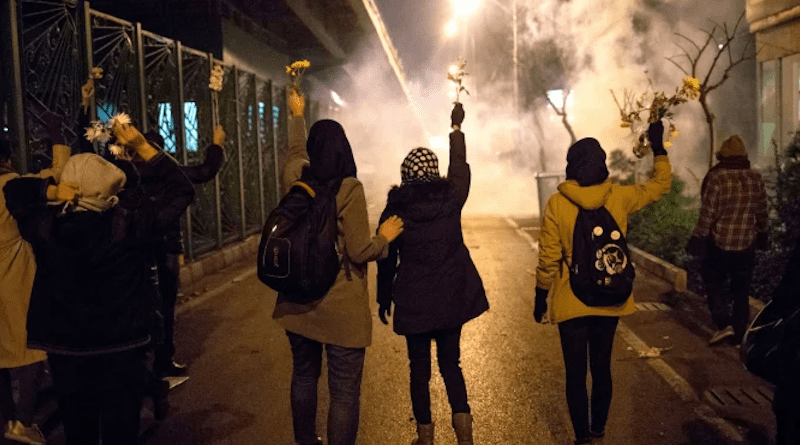The Mullahs Have Lost Iran’s Youth – OpEd
By Julian McBride
Ongoing protests in Iran have taken a brutal turn of late as emotions and rage continue to boil over following the death of Masha Amini. Yet the upheaval is just the latest manifestation of underlying tensions that have existed for decades, fueled by a growing gender gap, lack of due process, child marriages, inflation, corruption, and degrading rules for women – all of which are now leading the citizens of Iran to take direct aim at the regime.
As with any dictatorship, Khamenei and the Mullahs have resorted to lethal force to brutally suppress protestors, as they have done in the past. But these harsh tactics have failed to persuade Iranian citizens to stop. The result has been a cycle of escalation whereby the regime’s police and military continue to ramp up their repression while the protests grow ever stronger and ever more targeted at not just piecemeal reform but at displacing the Mullahs entirely.
Where the protests go from here is still up in the air. However, as Iran’s youngest and brightest continue to lead the charge, it’s clear that Tehran has lost influence on its youth indefinitely.
Though the Islamic Revolution began with student’s protests, the Mullahs led by Ayatollah Khomeini took advantage of revolutionary fervor to install themselves as head of the new Islamic Republic. This new Iran became a non-secular theocracy with religious laws taking precedent over human rights. There were various crackdowns and executions of progressives, revolutionaries, lawyers, oil executives, liberal women, and teachers with a secular point of view. Thus, the Islamic Revolution devolved into nothing more than a power play which swapped one brutal autocrat with an even more hardline theocratic one.
Despite the implementation of Islamic law, Iranians at home and among the diaspora continued to fight for rights, progress, and education; the latter of which Ayatollah Khomeini feared the most. As with any dictatorship, the Islamic Republic took precedent over social systems and attempted to export the “revolution” across the Middle East. Iranian citizens at home would be neglected in order to further foreign conflicts with countries like Saudi Arabia, Iraq, Israel, and the U.S.
Lebanon was one of the first priorities of Khomeini’s expansion, as the long-marginalized Shiite Muslims of the south were caught between the PLO and Israel, both of which they were embroiled in conflict with. The IRGC would help found Hezbollah, with a goal of creating an Islamic theocracy in Lebanon. Pro-Iranian Shiite militias would be funded and armed following the U.S invasion of Iraq to attack US forces and establish another foothold of Iranian influence. Militias in Gaza and the West Bank have been armed for proxy war against Israel, and the Houthis in Yemen were found to have weapons shipments directly from Tehran in their war against the Saudis and the Saudi-backed government-in-exile. While the IRGC continues to export military technology, the world’s most powerful non-state militias in the Middle East continue to answer directly to the Iranian regime.
Thus, while Iranians suffered from rising costs of living inflation and no freedom of speech, the Islamic Republic focused on facilitating “revolution” through its proxies in Lebanon, Syria, Iraq, Palestine, and Yemen. Consequently, the regime remains deeply unpopular with the younger generation and is forced to rely on paramilitary groups and militias to promote the “good side” of the Khomeinists. These proxies continue to sow doubt in the validity of Masha Amini’s death, and repeat the framing used by Ayatollah Khamenei that the protests represent an “ongoing coup” by the U.S and Israel, which in turn serves to discredit the movement and justify executions.
Yet the protests defy any easy answer. Gender apartheid has long been a staple of the Islamic Republic, as women are not viewed as equal under the law and are viewed as a man’s “property.” The ideology has contributed to an estimated 8,000 honor killings of women by men who are emboldened by state-sanctioned violence. Women who are not wearing the hajib are routinely beaten in public by the Basij and at times are killed, with the Mullahs never punishing their murderers. Child marriages have also been legalized under the Islamic Republic, correlating with the rising suicide rate amongst the younger population, as young females are often trapped with no way to escape their abusers.
Tehran continues a policy of extrajudicial killings, such as public hangings, not seen in most areas of the world today. State-sanctioned executions are presided over by the religious council, also known as the “death council,”which is essentially a kangaroo court that predetermines the accused’s guilt without any due process.
Despite the fear of open conflict with geopolitical rivals such as the U.S, Israel, and the Gulf states, what the Iranian regime fears most is not bombs, but its educated youth at home. In a televised interview, Khamenei stated “the threat of universities is more dangerous than cluster bombs.” The regime has used bullets to kill dissidents, but they have not killed the revolutionary fervor and will of the people—and this is something that cannot be taken away.
The Islamic Republic is now in disarray, desperately searching for a way out of the crisis on favorable terms to keep the current regime in power. As the protests spread, there is growing panic within the inner circle that they have permanently lost the students of Iran after decades of placating regime hardliners. Though a full-blown revolution has yet to break out, as with any dictatorship, all it takes is certain well-placed military commanders to refuse to maim or kill their fellow citizen’s children. In other words, the spark could come at any time.
The views expressed in this article belong to the authors alone and do not necessarily reflect those of Geopoliticalmonitor.com

